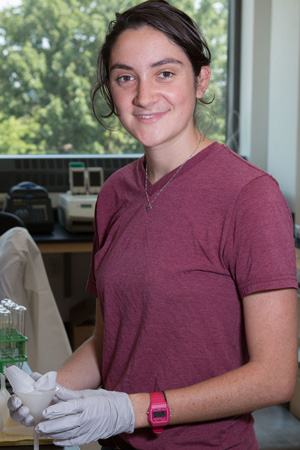Microbial stress responses may guide efforts to engineer bioproduct synthesis

Stress-induced metabolic changes highlight molecular targets for engineering bacteria to produce renewable alternatives to petrochemicals

The Science
Microbial production of fuels and other useful chemicals offers renewable alternatives to fossil fuel-derived products. Researchers at the Great Lakes Bioenergy Research Center (GLBRC) investigated how a prolific ethanol-producing microbe, Zymomonas mobilis, regulates its synthesis of a broad class of industrially relevant molecules called isoprenoids. The work identifies several enzymes that help the microbe overcome the rate-limiting steps in the methyl erythritol-4-phosphate (MEP) isoprenoid biosynthesis pathway.
The Impact
Isoprenoids are a broad class of natural products that include many industrial precursors and commodity chemicals. A better understanding of how Z. mobilis responds to oxygen-induced bottlenecks in the MEP pathway may identify promising targets for efforts to engineer microbial strains that produce higher levels of these valuable bioproducts.
Summary
Z. mobilis is very efficient at converting plant sugars into ethanol. Its metabolism may be readily harnessed for production of other organic compounds if carbon can be re-routed away from ethanol synthesis toward other product synthesis pathways. High levels of one type of naturally produced isoprenoid in the organism’s membranes suggest that it can drive carbon through the MEP isoprenoid biosynthesis pathway with high efficiency, making Z. mobilis a promising candidate for designing bacterial strains that transform plant material into specialty fuels and bioproducts.
The final catalyzed step in the MEP pathway requires an iron-sulfur cluster co-factor and is known to be the rate-limiting step in isoprenoid synthesis. In the new study, the researchers exposed Z. mobilis to oxygen, which disrupts the iron-sulfur cluster and induces a large bottleneck in the MEP pathway. The bacterium was able to resolve this bottleneck almost completely within an hour through upregulation of a relatively small number of enzymes, including several involved in the formation and maintenance of the iron-sulfur cluster. These results suggest that Z. mobilis has the capacity to shunt much more carbon through the MEP biosynthesis pathway than it does under normal anaerobic conditions, using a small number of regulatory changes. The enzymes used to maintain iron-sulfur cluster activity may be good targets for metabolic engineering to increase microbial production of isoprenoids.
Program Manager
N. Kent Peters
Program Manager, Office of Biological and Environmental Research
kent.peters@science.doe.gov, 301-903-5549
Corresponding Author
Daniel Amador-Noguez
University of Wisconsin–Madison
amadornoguez@wisc.edu
Funding
This work was supported by the DOE Great Lakes Bioenergy Research Center (DOE BER Office of Science DE-FC02-07ER64494 and DE-SC0018409).
Publication
J. I. Martien et al. “Systems-level analysis of oxygen exposure in Zymomonas mobilis: Implications for isoprenoid production.” mSystems 4, e00284-18 (2019). [DOI: 10.1128/mSystems.00284-18]
Related Link
https://msystems.asm.org/content/4/1/e00284-18